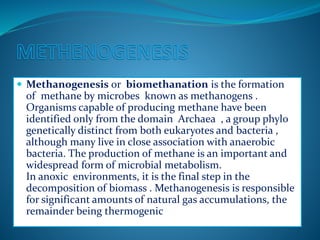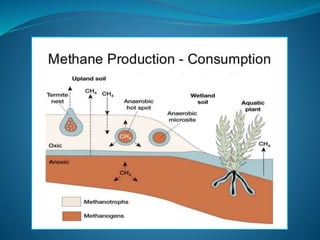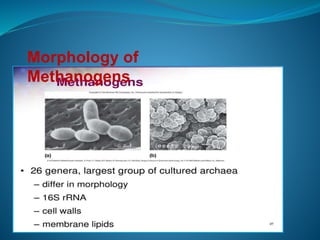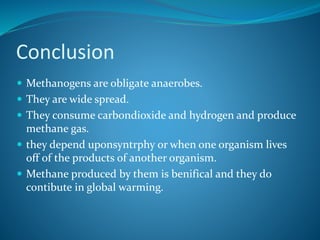Methanogens by kk sahu
- 1. METHANOGENS By KAUSHAL KUMAR SAHU Assistant Professor (Ad Hoc) Department of Biotechnology Govt. Digvijay Autonomous P. G. College Raj-Nandgaon ( C. G. )
- 2. OVERVIEW General introduction. History of methanogens Ecology and habitat of methanogens. Morphology of methanogens. Diversity found in methanogens. Characterstics of some model methanogens. Metabolism of methanogens: Methanogenesis Cofactors and coenzymes of methanogenesis Different pathways used during methanogenesis Energy conservation. Pros and cons of methanogens. Application References.
- 3. Methanogenesis or biomethanation is the formation of methane by microbes known as methanogens . Organisms capable of producing methane have been identified only from the domain Archaea , a group phylo genetically distinct from both eukaryotes and bacteria , although many live in close association with anaerobic bacteria. The production of methane is an important and widespread form of microbial metabolism. In anoxic environments, it is the final step in the decomposition of biomass . Methanogenesis is responsible for significant amounts of natural gas accumulations, the remainder being thermogenic
- 5. HISTORY In 1776, Alessandro Volta -combustible air that was reported to him by a friend, Father Carlo Campi on a little boat in Lake Maggiore. In 1977, Carl Woese and Ralph Wolfe resulted in the finding that the methanogens were ‘only distantly related to typical bacteria. Thus, the methanogens became the first known Archaea. They are now known to comprise five orders of the Euryarchaeota: Methanococcales, Methanosarcinales , Methanobacteriales, Methanomicrobiales, and Methanopyrales (Liu & Whitman, 2008). Alessandro Volta
- 13. Natural occurrence In ruminants Testing Australian sheep for exhaled methane production (2001), CSIRO Enteric fermentation occurs in the gut of some animals, especially ruminants. In the rumen, anaerobic organisms, including methanogens , digest cellulose into forms nutritious to the animal. Without these microorganisms, animals such as cattle would not be able to consume grasses. The useful products of methanogenesis are absorbed by the gut, but methane is released from the animal mainly by belching (eructation). The average cow emits around 250 liters of methane per day. In this way, ruminants contribute about 25% of anthropogenic methane emissions. One method of methane production control in ruminants is by feeding them 3-nitrooxypropanol.
- 14. Some humans produce flatus that contains methane. In one study of the feces of nine adults, five of the samples contained archaea capable of producing methane. Similar results are found in samples of gas obtained from within the rectum. Even among humans whose flatus does contain methane, the amount is in the range of 10 % or less of the total amount of gas In humans
- 16. In plants Many experiments have suggested that leaf tissues of living plants emit methane.Other research has indicated that the plants are not actually generating methane; they are just absorbing methane from the soil and then emitting it through their leaf tissues
- 19. MORPHOLOGY Methanogens are made primarily in two shapes, cocci and rods. Can also be found having a plate like structure. Several genera have walls with pseudomurein. Other walls contain either proteins or heteropolysaccharides.
- 21. Pros & Cons of Methanogenesis
- 22. PROS OF METHANE PRODUCED BY METHANOGENS Methanogenic archaEa are potentially of great practical importance since methane is an excellent energy source. Commercially used, in hotels, restaurants, motels, small manufacturing units, commercial office buildings, hospitals and schools mainly for cooking and heating purposes.
- 23. Natural gas can be used as a fuel for vehicles (cars, trucks, jet engines). It is a cleaner, cheaper fuel than diesel or gasoline. For many years sewage treatment plants have been using the methane they produce as anaerobic digester microbes that will degrade particulate wastes such as sewage sludge to H₂, CO₂, and acetate.
- 24. CONS OF METHANE FORMATION Damage to Environment: Burning of natural gas also releases compounds which are greenhouse gases that cause global warming and climate changes. Toxic and Flammable: Leaks of natural gas are tremendously dangerous. Such leaks may cause explosions or fire. When inhaled, the gas is highly toxic.
- 25. Conclusion Methanogens are obligate anaerobes. They are wide spread. They consume carbondioxide and hydrogen and produce methane gas. they depend uponsyntrphy or when one organism lives off of the products of another organism. Methane produced by them is benifical and they do contibute in global warming.
- 26. REFERENCES


























